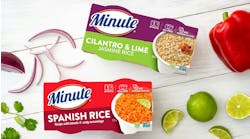The term ancient grains refers to some of the oldest varieties of grains, ones that have not been bred and changed by humans over the thousands of years that they have been grown and consumed. In the past five years, product developers and chefs have embraced ancient grains for use in all types of foods, beyond traditional baked goods.
The most common ancient grains are amaranth, buckwheat, bulgur, kamut, millet, quinoa, sorghum and teff, all of which provide whole-grain nutrition, with each grain delivering unique flavors and textures. Many ancient grains are also gluten-free, making them possible substitutes for wheat flours. Ancient grains typically come in flour, flake and sprouted formats, rendering them suitable for varied applications. Some of the grains themselves and flours made from them are being marketed alongside standard flour, corn meal and other specialty flours in the baking aisle. They can also be found in the rice aisle, packaged and sold for use as side dishes and recipe use.
“For some consumers, the attraction of ancient grains is the bundle of benefits that manifests as simplicity, resulting from not being grown or processed on a large scale, meaning they are more likely to be organic, produced naturally without any genetic modification, offering considerable nutritional value,” says David Sprinkle, research director of Packaged Facts, Rockville, Md. “Interest in sprouted grains and other sprouted ingredients is growing consistent with more consumers paying attention to digestive health, a desire for greater nutritional value generally and in conjunction with raw foods.”
“The term ancient grains is grounding. It lends an element of trust.”
- Suzy Badaracco, president, Culinary Tides Inc., San Francisco
Products to watch out for
Breakfast Bowls
Melanie’s Medleys debuts a line of single-serve, ready-to-eat breakfast bowls. The vegetarian product combines ancient grains such as barley, farro, freekah and quinoa with a light coconut and almond milk base, along with other characterizing flavorful ingredients. Varieties are Caramel Apple; Chocolate, Coconut & Almond; Cinnamon Walnut; Fruit & Almond; Peanut Butter Chocolate Chip; and Tropical. The company also recently expanded its clean-label, small-batch cream cheese line with Cinnamon Toast and Salted Caramel varieties.
Dual-compartment Greek Yogurt
New Fage Crossovers invite consumers to experience chef-level snacking with a variety of yogurt cuisines that are as distinct as they are delicious, according to the company. The dual-compartment 150g containers have strained 1.5 percent milkfat yogurt on one side and crunchy toppings on the other. The Maple Syrup with Ancient Grains Granola variety includes puffed amaranth, millet flakes and quinoa flakes, along with chia and sunflower seeds. The yogurt yogurts contain 190 calories, 5g of fat and 14g of protein.
Puffed Dino Snack for Tots
Nurture Inc. grows its organic HappyTot line with dinosaur-shaped puffed snacks based on amaranth and quinoa. The gluten-free snacks come in Kale, Spinach & Cheddar and Tomato, Basil & Cheddar varieties. Each serving, about 20 pieces, delivers 25mg of choline -- an important nutrient that helps support growth -- and 5g of whole grains. The non-GMO snacks come in 1.5-oz. multi-serve recloseable bags. The company uses ancient grains in a number of other offerings, including pouch meals for babies.


